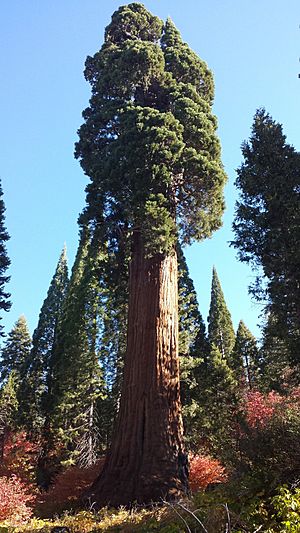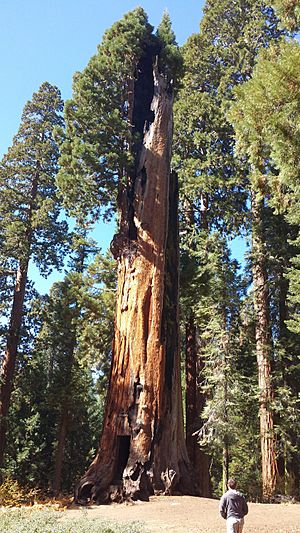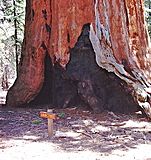Mountain Home Grove facts for kids
Quick facts for kids Mountain Home Grove |
|
|---|---|
| Location | Giant Sequoia National Monument (Tulare County) |
| Nearest city | Springville, CA |
| Area | 4,800 acres (19.4 km2) |
| Elevation | 6,460 ft (1,970 m) |
| Governing body | U.S. Forest Service, Mountain Home State Forest, and Balch County Park |


Mountain Home Grove is a special place in the southern Sierra Nevada Mountains of California. It's home to many incredible Giant Sequoia trees, some of which are among the biggest in the entire world!
Contents
What is Mountain Home Grove?
Mountain Home Grove is a forest filled with giant sequoia trees. It is located in different areas. Part of it is in Balch Park, which is managed by Tulare County. Another part is in the Mountain Home Demonstration State Forest. The rest is in the Giant Sequoia National Monument. This monument used to be part of the Sequoia National Forest.
This grove is very important because it has four of the 20 largest Giant Sequoia trees by size. It also has many other famous trees. This makes Mountain Home the second biggest grove of sequoias. Only the Giant Forest in Sequoia National Park is larger.
Mountain Home Grove is easy to reach from cities like Fresno and Porterville. It also has fewer visitors than other groves in national parks. This makes it a great place to see Giant Sequoias.
History of the Grove
Early Days and Logging
In 1875, a famous nature writer named John Muir described this area. He called the sequoia groves here "the finest block of Sequoia in the entire belt." This meant he thought they were the best group of sequoia trees anywhere.
However, logging started in the 1870s. Many huge trees were cut down. This included the Centennial tree, which many people thought was the biggest tree on Earth.
Saving the Trees
Luckily, some people wanted to save these amazing trees. In the 1880s, two pioneers named John Doyle and Jesse Hoskins bought land in the heart of the grove. Doyle even ran a resort called "Summer Home" there. Hoskins simply wanted to protect the big trees from being cut down.
Another couple, Andrew Jackson Doty and his wife Sarah, built a popular hotel nearby. They called it "Mountain Home." This is how the grove got its name.
Many trees in the Mountain Home Grove were logged. But the trees on Doyle's and Hoskins' land were saved. Today, Doyle's "Summer Home" is part of Balch Park. This is a park managed by Tulare County. Much of the forest around it, including Hoskins' trees, is now part of a California State project. It's called the Mountain Home State Demonstration Forest.
Logging continued in other parts of the grove until 1956. But since then, no major tree cutting has happened. Only small amounts of wood are removed to prevent fires and protect the largest trees.
Becoming a National Monument
On April 15, 2000, Mountain Home Grove became part of the new Giant Sequoia National Monument. The National Forest Service now manages it. Balch Park is still managed by Tulare County. The State Demonstration Forest remains under California's control.
Discovering New Giants
Hoskins and Doyle named many of the big trees long ago. But a century later, a retired math teacher named Wendell Flint started looking for more. With help from photographer Mike Law, he searched for large Sequoias that had been missed.
They found and measured several new Sequoias. These trees are now among the largest living trees on Earth. Three of these trees in Mountain Home Grove are now in the top forty largest trees by size.
Famous Trees in the Grove
Here are some of the most famous trees you can find in Mountain Home Grove:
- Genesis tree: This is the 7th largest tree in the world. Wendell Flint discovered it in 1985. He also wrote a book called To Find the Biggest Tree.36°12′54″N 118°40′10″W / 36.215119°N 118.669395°W
- Summit Road tree: This tree is the 15th largest in the world. Wendell Flint also identified this huge tree.
- Euclid tree: This is the 16th largest tree in the world. Wendell Flint identified it as a large tree in 1989. It is very tall for a Giant Sequoia, at 273 feet (83.2 m). The tops of most of the biggest trees have been damaged by lightning. This has made them shorter.36°14′36″N 118°40′22″W / 36.243404°N 118.672651°W
- Adam tree: This tree is the 20th largest in the world. Before Wendell Flint started his search in the 1980s, people thought this was the biggest tree in Mountain Home Grove.
- Methuselah tree: This is the 27th largest tree in the world. This Sequoia has a broken top. But its base is unusually wide. It's as wide as the famous Boole tree in the Converse Basin Grove.36°12′26″N 118°41′03″W / 36.207319°N 118.684217°W
- Hercules Tree: In the 1890s, Jesse Hoskins carved a room inside this tree. The room is 12 feet (3.7 m) wide and 9 feet (2.7 m) high. Visitors can still go inside and explore it! Even with this room and a burned top from lightning, the Hercules tree is still alive and growing.36°14′19″N 118°41′03″W / 36.238536°N 118.68408°W
- Great Bonsai tree: Wendell Flint calls this tree "one of the greatest sequoia sights to be seen anywhere." It has several large branches that reach close to the ground. The tree also sits on top of a pile of big rocks, making it look very impressive.36°13′07″N 118°40′06″W / 36.218480°N 118.66822°W
- Centennial Stump: People once said this was the largest tree in the world before it was cut down in 1878. It was used for a special exhibition. Recent measurements of the stump show this might have been an exaggeration. But the stump is 24 feet (7.3 m) wide and 86.9 feet (26.5 m) around. This means if the tree were still alive, it would definitely be one of the "big ones."36°14′25″N 118°40′49″W / 36.240254°N 118.680249°W
- Hollow Log: This is a naturally hollowed-out log from a fallen Giant Sequoia. People used it as a shelter as early as 1856. Today, it's one of the main attractions at Balch County Park.36°13′13″N 118°40′46″W / 36.220404°N 118.679318°W
Gallery of Tree Pictures
Here are some pictures of the amazing Giant Sequoias in the Mountain Home Grove.
-
Genesis tree, the 7th largest tree, was not identified until 1985
-
Adam tree, 20th largest, once thought to be the largest tree in Mountain Home.
-
1902 photo of the entrance to Jesse Hoskin's Hercules tree.






